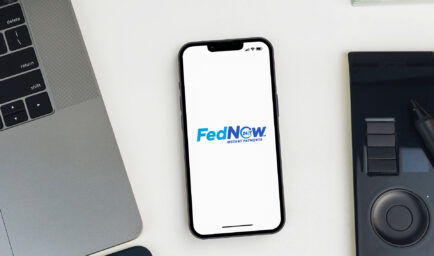Exploring the FedNow Service and Instant Payments
It’s no secret we like instant gratification—and the same holds true for payments. Instant payment adoption has grown due to consumers’ expectation of on-demand services that prioritize speed and convenience. In a recent survey, PYMNTS found that 72% of respondents would say “yes” when given the opportunity to receive instant payments. To help meet this widespread consumer demand, the Federal Reserve established a nationwide instant payments infrastructure by launching the FedNow Service in 2023.
Want to learn the latest on the FedNow Service? Read on to explore the instant payments landscape and the advantages of FedNow.
What’s the Difference between Real-Time and Instant Payments?
A real-time or instant payment is a financial transaction that is initiated and processed almost immediately. Unlike traditional payment methods which can take hours or days to process, these payments process within seconds.
The primary difference in real-time or instant payments is the operator of the payment system. Two major real-time payments networks currently exist and are operated by different groups. The Clearing House was first to market in 2017 with its RTP®, a service operated by a group of large commercial banks. The U.S. Federal Reserve operates FedNow, an instant payments network designed to provide secure, fast payments for all financial institutions.

What is the FedNow Service?
In July 2023, the Fed launched its FedNow Service, an instant payment infrastructure that allows eligible, participating institutions to provide instant payments services. Institutions are not required to participate in the FedNow Service, but many have opted in to provide instant payment capabilities to customers.
Since FedNow supports instant payments, users can access funds in their accounts at any time. With around-the-clock, real-time processing, funds are always available, and money is transferred when a payment is sent. Because settlement occurs in seconds, payments are final, so the full amount of the funds are available for the receiver to use right away.
Why Did the Fed Launch FedNow?
Seven in 10 businesses and consumers say they prefer accessing faster payment services. Recognizing consumers’ demand for convenience and nearly instant access to their funds, the Fed created the FedNow service to modernize the U.S. payment system.
While RTP was first to market, many institutions were waiting for additional demand and payment volume to drive instant payment adoption. CSI’s 2024 Banking Priorities survey revealed 33% of bankers selected FedNow as a top priority, indicating their interest in partnering with the Fed for instant payments.
According to the Fed, “Instant payments allow consumers and businesses to send and receive funds from their accounts at banks and credit unions in real time, any time of day, any day of the year, with immediate funds availability to receivers.”
Which Banks are Using the FedNow Service?
Since its launch in 2023, the FedNow Service has connections to more than 900 financial institutions headquartered in all 50 states. According to the Fed, community banks and credit unions comprise nearly 80% of total participating financial institutions.
The Fed maintains a list of participating financial institutions that have completed the necessary testing and certifications. Banks can opt to be enabled to both send and receive payments or choose the “receive only” option. Joining as a receive-only bank at minimum allows banks to receive a payment and make it available to their customers instantly.
Some banks jumped in early to take advantage of the competitive edge instant payments provide while others are evaluating the experience and market. Since FedNow is a network purpose-built for banks, all institutions—no matter the size—can derive value from it.

Is FedNow Mandatory for Banks?
While FedNow is not mandatory, U.S. financial institutions have continued to implement the service to enhance their user experience. Since most consumers have adopted digital banking, they’re comfortable conducting their banking activities and transactions online. By offering an alternative to traditional payment systems, FedNow instant payments help banks meet consumer expectations while lowering transaction fees and additional expenses.
Why Should Banks Adopt the FedNow Service?
With the changing payments landscape, the ability to receive FedNow payments can set your bank apart. Embracing FedNow shows your technology proficiency as a financial institution, especially as customers crave convenient, speedy services.
FedNow provides institutions with the option to provide another product or service for business customers that keeps them “sticky,” or more likely to use their institution when additional banking needs arise. As the send capabilities grow, especially with B2C or B2B payments, instant payments can open avenues to drive revenue growth and create additional revenue streams for institutions.
Are Instant Payments Secure?
Risk exists with any type of payment, even instant payments. Since transactions are processed 24x7x365, fraudsters have endless opportunities to strike. Once processed, instant payments are final, representing additional risk. However, there are controls in place to help institutions and consumers mitigate security and fraud risk.
Since the Fed is already a trusted partner to community banks, institutions should feel comfortable working with this system, especially since the Fed built their payments system with security in mind. To protect digital data confidentiality, FedNow data is encrypted at rest and in transit, and some data is even tokenized. The network itself also has a fraud negative list, which allows the sending or receiving bank to block FedNow transactions to or from certain accounts.
Transaction limits are offered at the network and participant level to help institutions mitigate risk. The network-level maximum credit transfer transaction value is $500,000 and set by the Fed. Participants have a default transaction limit of $100,000 set at the routing transit number (RTN) level. Institutions have the option to increase or decrease the limit to ensure alignment with their specific risk profile and needs, keeping the maximum default limit in mind.
Further, when FedNow participants confirm a fraudulent transaction through their own investigation, they must report it to the FedNow Service. This reporting and information sharing helps strengthen the network and support fraud mitigation. Institutions should also continue educating their customers about ways to protect themselves and identify potentially fraudulent activity.

Will FedNow Replace Cash?
According to the Fed, “The FedNow Service is neither a form of currency nor a step toward eliminating any form of payment, including cash.” FedNow is like other existing Federal Reserve payment services like Fedwire or FedACH. The FedNow Service is also not related to digital currency.
What’s the Future of Instant Payments?
FedNow is the payment network of the future, but it will be a marathon—not a sprint—to reach its full potential. When it comes to future developments, one area of focus could be government payments that your institution receives. All banks have customers receiving government payments, and banks should prepare for the potential for these payments to be received via FedNow in the future. Request for payments (RFP) is another future use and has the potential to significantly change how consumers pay bills.
FedNow helps consumers expedite bill payments for business and individual customers, including for B2B, B2C and C2B scenarios. Small businesses can now receive payments instantly, instead of having to wait a few days for the transaction to process. Here’s another example: a utility company could send customers a request for payment and receive the funds instantly after the payment was authorized, reducing manual processing and improving the customer experience.
As the landscape evolves, technology providers will emerge to help institutions capitalize on new use cases for instant payments.
Moving Forward with FedNow
Whether you’ve been following the rollout of FedNow or just now considering adoption, continued education around the topic is key. As you determine your strategy, make sure you understand the network as a whole and its use cases to maximize the benefits for your institution. Talk to your technology providers to ensure you understand their approach as well.
If you’re just getting started on your instant payments journey, consider taking a readiness assessment from the Fed to ensure your processing environment is compatible with the FedNow Service. You’ll also need to determine operational impacts, including reviewing your internal processes and staffing.
Want to Dive Deeper into the World of Payments?
FedNow’s instant capabilities enable banks to elevate their customer experience with faster, more efficient services—all while driving economic growth and innovation. Learn more about the payments and banking landscape in our white paper.

Greg is responsible for ensuring payments applications remain competitive and compliant in today’s rapidly evolving landscape. Greg also holds accreditations as an AAP—Accredited ACH Professional and CTP—Certified Treasury Professional. In addition, Greg is an active participant in payment industry work groups working to help advise the industry on the future of payments. Greg is also a member EPCOR’s Education Committee working to help provide guidance, direction and support for EPCOR’s Payments Education offerings.

